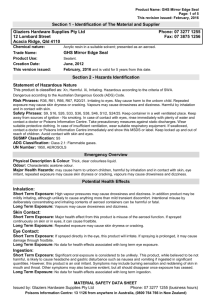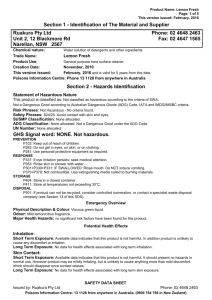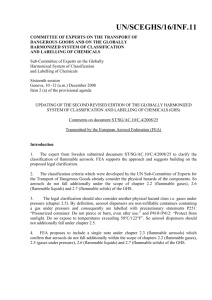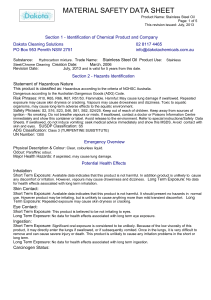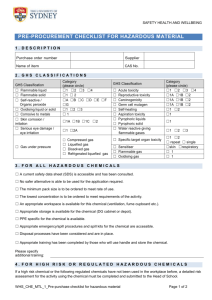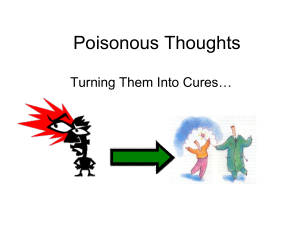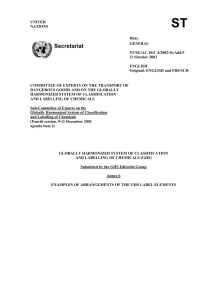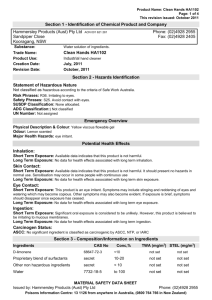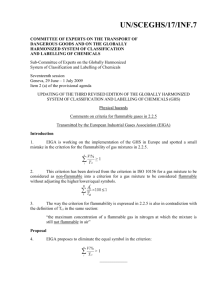to Supersolve
advertisement
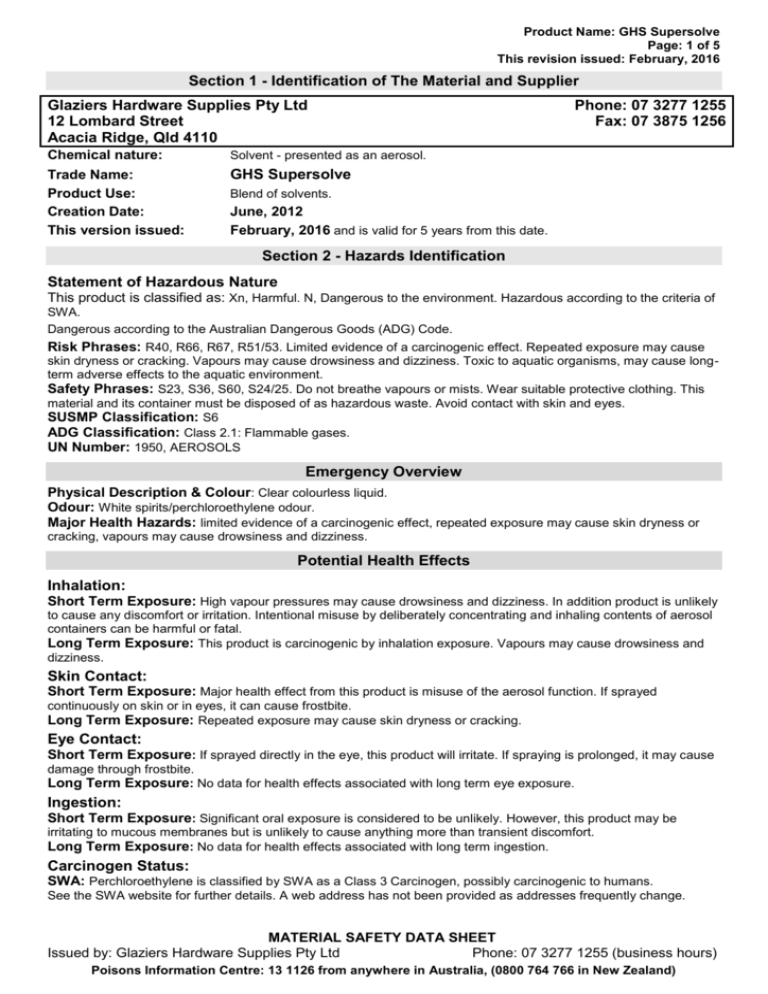
Product Name: GHS Supersolve Page: 1 of 5 This revision issued: February, 2016 Section 1 - Identification of The Material and Supplier Glaziers Hardware Supplies Pty Ltd 12 Lombard Street Acacia Ridge, Qld 4110 Chemical nature: Solvent - presented as an aerosol. Trade Name: Product Use: Creation Date: This version issued: GHS Supersolve Phone: 07 3277 1255 Fax: 07 3875 1256 Blend of solvents. June, 2012 February, 2016 and is valid for 5 years from this date. Section 2 - Hazards Identification Statement of Hazardous Nature This product is classified as: Xn, Harmful. N, Dangerous to the environment. Hazardous according to the criteria of SWA. Dangerous according to the Australian Dangerous Goods (ADG) Code. Risk Phrases: R40, R66, R67, R51/53. Limited evidence of a carcinogenic effect. Repeated exposure may cause skin dryness or cracking. Vapours may cause drowsiness and dizziness. Toxic to aquatic organisms, may cause longterm adverse effects to the aquatic environment. Safety Phrases: S23, S36, S60, S24/25. Do not breathe vapours or mists. Wear suitable protective clothing. This material and its container must be disposed of as hazardous waste. Avoid contact with skin and eyes. SUSMP Classification: S6 ADG Classification: Class 2.1: Flammable gases. UN Number: 1950, AEROSOLS Emergency Overview Physical Description & Colour: Clear colourless liquid. Odour: White spirits/perchloroethylene odour. Major Health Hazards: limited evidence of a carcinogenic effect, repeated exposure may cause skin dryness or cracking, vapours may cause drowsiness and dizziness. Potential Health Effects Inhalation: Short Term Exposure: High vapour pressures may cause drowsiness and dizziness. In addition product is unlikely to cause any discomfort or irritation. Intentional misuse by deliberately concentrating and inhaling contents of aerosol containers can be harmful or fatal. Long Term Exposure: This product is carcinogenic by inhalation exposure. Vapours may cause drowsiness and dizziness. Skin Contact: Short Term Exposure: Major health effect from this product is misuse of the aerosol function. If sprayed continuously on skin or in eyes, it can cause frostbite. Long Term Exposure: Repeated exposure may cause skin dryness or cracking. Eye Contact: Short Term Exposure: If sprayed directly in the eye, this product will irritate. If spraying is prolonged, it may cause damage through frostbite. Long Term Exposure: No data for health effects associated with long term eye exposure. Ingestion: Short Term Exposure: Significant oral exposure is considered to be unlikely. However, this product may be irritating to mucous membranes but is unlikely to cause anything more than transient discomfort. Long Term Exposure: No data for health effects associated with long term ingestion. Carcinogen Status: SWA: Perchloroethylene is classified by SWA as a Class 3 Carcinogen, possibly carcinogenic to humans. See the SWA website for further details. A web address has not been provided as addresses frequently change. MATERIAL SAFETY DATA SHEET Issued by: Glaziers Hardware Supplies Pty Ltd Phone: 07 3277 1255 (business hours) Poisons Information Centre: 13 1126 from anywhere in Australia, (0800 764 766 in New Zealand) Product Name: GHS Supersolve Page: 2 of 5 This revision issued: February, 2016 NTP: Perchloroethylene is classified by NTP as reasonably anticipated to be carcinogenic to humans. See the NTP website for further details. A web address has not been provided as addresses frequently change. IARC: Perchloroethylene is classed 2a by IARC - probably carcinogenic to humans. See the IARC website for further details. A web address has not been provided as addresses frequently change. Section 3 - Composition/Information on Ingredients Ingredients CAS No Conc,% TWA (mg/m3) STEL (mg/m3) Alkanes, C3-4 68475-59-2 not set not set Perchloroethylene 127-18-4 >60 340 1020 White spirit 64475-85-0 10-30 not set not set This is a commercial product whose exact ratio of components may vary slightly. Minor quantities of other non hazardous ingredients are also possible. The SWA TWA exposure value is the average airborne concentration of a particular substance when calculated over a normal 8 hour working day for a 5 day working week. The STEL (Short Term Exposure Limit) is an exposure value that may be equalled (but should not be exceeded) for no longer than 15 minutes and should not be repeated more than 4 times per day. There should be at least 60 minutes between successive exposures at the STEL. The term "peak "is used when the TWA limit, because of the rapid action of the substance, should never be exceeded, even briefly. Section 4 - First Aid Measures General Information: You should call The Poisons Information Centre if you feel that you may have been poisoned, burned or irritated by this product. The number is 13 1126 from anywhere in Australia (0800 764 766 in New Zealand) and is available at all times. Have this MSDS with you when you call. Inhalation: First aid is not generally required. If in doubt, contact a Poisons Information Centre or a doctor. Skin Contact: Gently blot away excess liquid. Wash gently and thoroughly with water (use non-abrasive soap if necessary) for 5 minutes or until chemical is removed. Eye Contact: Quickly and gently blot material from eyes. No effects expected. If irritation does occur, flush contaminated eye(s) with lukewarm, gently flowing water for 5 minutes or until the product is removed. Obtain medical advice if irritation becomes painful or lasts more than a few minutes. Take special care if exposed person is wearing contact lenses. Ingestion: If product is swallowed or gets in mouth, do NOT induce vomiting; wash mouth with water and give some water to drink. If symptoms develop, or if in doubt contact a Poisons Information Centre or a doctor. Section 5 - Fire Fighting Measures Fire and Explosion Hazards: The major hazard in fires is usually inhalation of heated and toxic or oxygen deficient (or both), fire gases. There is a moderate risk of an explosion from this product if commercial quantities are involved in a fire. Firefighters should take care and appropriate precautions. Violent steam generation or eruption may occur upon application of direct water stream on hot liquids. Vapours from this product are heavier than air and may accumulate in sumps, pits and other low-lying spaces, forming potentially explosive mixtures. They may also flash back considerable distances. Fire decomposition products from this product may be toxic if inhaled. Take appropriate protective measures. Extinguishing Media: Suitable extinguishing media are carbon dioxide, dry chemical, foam, water fog. Water fog or fine spray is the preferred medium for large fires. Try to contain spills, minimise spillage entering drains or water courses. Fire Fighting: If a significant quantity of this product is involved in a fire, call the fire brigade. There is a danger of a violent reaction or explosion if significant quantities of this product are involved in a fire. Recommended personal protective equipment is full fire kit and breathing apparatus. Cool closed, undamaged containers exposed to fire with water spray. Flash point: Propellant is flammable; liquid phase no data. Upper Flammability Limit: Not available Lower Flammability Limit: Not available Autoignition temperature: No data. Flammability Class: No data. Section 6 - Accidental Release Measures Accidental release: This product is sold in small packages, and the accidental release from one of these is not usually a cause for concern. For minor spills, clean up, rinsing to sewer and put empty container in garbage. Although no special protective clothing is normally necessary because of occasional minor contact with this product, it is good MATERIAL SAFETY DATA SHEET Issued by: Glaziers Hardware Supplies Pty Ltd Phone: 07 3277 1255 (business hours) Poisons Information Centre: 13 1126 from anywhere in Australia, (0800 764 766 in New Zealand) Product Name: GHS Supersolve Page: 3 of 5 This revision issued: February, 2016 practice to wear impermeable gloves when handling chemical products. In the event of a major spill, prevent spillage from entering drains or water courses and call emergency services. Section 7 - Handling and Storage Handling: Keep exposure to this product to a minimum, and minimise the quantities kept in work areas. Check Section 8 of this MSDS for details of personal protective measures, and make sure that those measures are followed. The measures detailed below under "Storage" should be followed during handling in order to minimise risks to persons using the product in the workplace. Also, avoid contact or contamination of product with incompatible materials listed in Section 10. Storage: This product is a Scheduled Poison. Observe all relevant regulations regarding sale, transport and storage of this schedule of poison. Store in a cool, well ventilated area, and make sure that surrounding electrical devices and switches are suitable. Check containers and valves periodically for leaks. If you keep more than 25kg of flammable gases, you are probably required to license the premises or notify your Dangerous Goods authority. If you have any doubts, we suggest you contact your Dangerous Goods authority in order to clarify your obligations. Check packaging - there may be further storage instructions on the label. Section 8 - Exposure Controls and Personal Protection The following Australian Standards will provide general advice regarding safety clothing and equipment: Respiratory equipment: AS/NZS 1715, Protective Gloves: AS 2161, Occupational Protective Clothing: AS/NZS 4501 set 2008, Industrial Eye Protection: AS1336 and AS/NZS 1337, Occupational Protective Footwear: AS/NZS2210. SWA Exposure Limits TWA (mg/m3) STEL (mg/m3) Perchloroethylene 340 1020 No special equipment is usually needed when occasionally handling small quantities. The following instructions are for bulk handling or where regular exposure in an occupational setting occurs without proper containment systems. Ventilation: This product should only be used in a well ventilated area. If natural ventilation is inadequate, use of a fan is suggested. Eye Protection: Eye protection such as protective glasses or goggles is recommended when this product is being used. Skin Protection: You should avoid contact even with mild skin irritants. Therefore you should wear suitable impervious elbow-length gloves and facial protection when handling this product. See below for suitable material types. Protective Material Types: We suggest that protective clothing be made from the following materials: Viton, nitrile. Respirator: Usually, no respirator is necessary when using this product. However, if you have any doubts consult the Australian Standard mentioned above. Safety deluge showers should, if practical, be provided near to where this product is being handled commercially. Section 9 - Physical and Chemical Properties: Physical Description & colour: Odour: Boiling Point: Freezing/Melting Point: Volatiles: Vapour Pressure: Vapour Density: Specific Gravity: Water Solubility: pH: Volatility: Odour Threshold: Evaporation Rate: Coeff Oil/water Distribution: Autoignition temp: Clear colourless liquid. White spirits/perchloroethylene odour. Not available. No specific data. Liquid at normal temperatures. No data. No data. No data. >1 Insoluble. No data. No data. No data. No data. No data No data. Section 10 - Stability and Reactivity Reactivity: This product is unlikely to react or decompose under normal storage conditions. However, if you have any doubts, contact the supplier for advice on shelf life properties. MATERIAL SAFETY DATA SHEET Issued by: Glaziers Hardware Supplies Pty Ltd Phone: 07 3277 1255 (business hours) Poisons Information Centre: 13 1126 from anywhere in Australia, (0800 764 766 in New Zealand) Product Name: GHS Supersolve Page: 4 of 5 This revision issued: February, 2016 Conditions to Avoid: This product should be kept in a cool place, preferably below 30°C. Keep containers tightly closed. Containers should be kept dry. Keep containers and surrounding areas well ventilated. Keep away from sources of sparks or ignition. Any electrical equipment in the area of this product should be flame proofed. Incompatibilities: strong reducing agents. Fire Decomposition: Combustion forms carbon dioxide, and if incomplete, carbon monoxide and possibly smoke. Water is also formed. May form hydrogen chloride gas, other compounds of chlorine. Carbon monoxide poisoning produces headache, weakness, nausea, dizziness, confusion, dimness of vision, disturbance of judgment, and unconsciousness followed by coma and death. Polymerisation: This product will not undergo polymerisation reactions. Section 11 - Toxicological Information Local Effects: Target Organs: There is no data to hand indicating any particular target organs. Classification of Hazardous Ingredients Ingredient Risk Phrases Perchloroethylene Conc>=1%: Xn; R40 Section 12 - Ecological Information Toxic to aquatic organisms, may cause long-term adverse effects to the aquatic environment. Insufficient data to be sure of biodegradability status. Section 13 - Disposal Considerations Disposal: Dispose of small quantities and empty containers by wrapping with paper and putting in garbage. For larger quantities, if recycling or reclaiming is not possible, use a commercial waste disposal service. Section 14 - Transport Information ADG Code: 1950, AEROSOLS Hazchem Code: 2YE Special Provisions: 63, 190, 277 Limited quantities: ADG 7 specifies a Limited Quantity value of 1000mL for this class of product. Dangerous Goods Class: Class 2.1: Flammable gases. Packaging Group: Not set Packaging Method: P003 Class 2.1 Flammable gases shall not be loaded in the same vehicle or packed in the same freight container with Classes 1 (Explosives), 3 (Flammable Liquids) (where both flammable liquids and flammable gases are in bulk), 4.1 (Flammable Solids), 4.2 (Spontaneously Combustible Substances), 4.3 (Dangerous When Wet Substances), 5.1 (Oxidising Agents), 5.2 (Organic Peroxides), and 7 (Radioactive Substances). They may however be loaded in the same vehicle or packed in the same freight container with Classes 2.2 (Non-flammable Non-Toxic gases), 3 (Flammable liquids except where both flammable liquids and flammable gases are in bulk), 6 (Toxic Substances), 8 (Corrosive Substances) 9 (Miscellaneous dangerous goods), Foodstuffs and foodstuff empties. Section 15 - Regulatory Information AICS: All of the significant ingredients in this formulation are compliant with NICNAS regulations. The following ingredients: Perchloroethylene, White spirit (a liquid hydrocarbon) are mentioned in the SUSMP. Section 16 - Other Information This MSDS contains only safety-related information. For other data see product literature. Acronyms: ADG Code AICS SWA CAS number Hazchem Code IARC Australian Code for the Transport of Dangerous Goods by Road and Rail (7 th edition) Australian Inventory of Chemical Substances Safe Work Australia, formerly ASCC and NOHSC Chemical Abstracts Service Registry Number Emergency action code of numbers and letters that provide information to emergency services especially firefighters International Agency for Research on Cancer MATERIAL SAFETY DATA SHEET Issued by: Glaziers Hardware Supplies Pty Ltd Phone: 07 3277 1255 (business hours) Poisons Information Centre: 13 1126 from anywhere in Australia, (0800 764 766 in New Zealand) Product Name: GHS Supersolve Page: 5 of 5 This revision issued: February, 2016 NOS NTP R-Phrase SUSMP UN Number Not otherwise specified National Toxicology Program (USA) Risk Phrase Standard for the Uniform Scheduling of Medicines & Poisons United Nations Number THIS MSDS SUMMARISES OUR BEST KNOWLEDGE OF THE HEALTH AND SAFETY HAZARD INFORMATION OF THE PRODUCT AND HOW TO SAFELY HANDLE AND USE THE PRODUCT IN THE WORKPLACE. EACH USER MUST REVIEW THIS MSDS IN THE CONTEXT OF HOW THE PRODUCT WILL BE HANDLED AND USED IN THE WORKPLACE. IF CLARIFICATION OR FURTHER INFORMATION IS NEEDED TO ENSURE THAT AN APPROPRIATE RISK ASSESSMENT CAN BE MADE, THE USER SHOULD CONTACT THIS COMPANY SO WE CAN ATTEMPT TO OBTAIN ADDITIONAL INFORMATION FROM OUR SUPPLIERS OUR RESPONSIBILITY FOR PRODUCTS SOLD IS SUBJECT TO OUR STANDARD TERMS AND CONDITIONS, A COPY OF WHICH IS SENT TO OUR CUSTOMERS AND IS ALSO AVAILABLE ON REQUEST. Please read all labels carefully before using product. This MSDS is prepared in accord with the SWA document “National Code of Practice for the Preparation of Material Safety Data Sheets” 2nd Edition [NOHSC:2011(2003)] Copyright © Kilford & Kilford Pty Ltd, February, 2016. http://www.kilford.com.au/ Phone (02)9251 4532 MATERIAL SAFETY DATA SHEET Issued by: Glaziers Hardware Supplies Pty Ltd Phone: 07 3277 1255 (business hours) Poisons Information Centre: 13 1126 from anywhere in Australia, (0800 764 766 in New Zealand)
